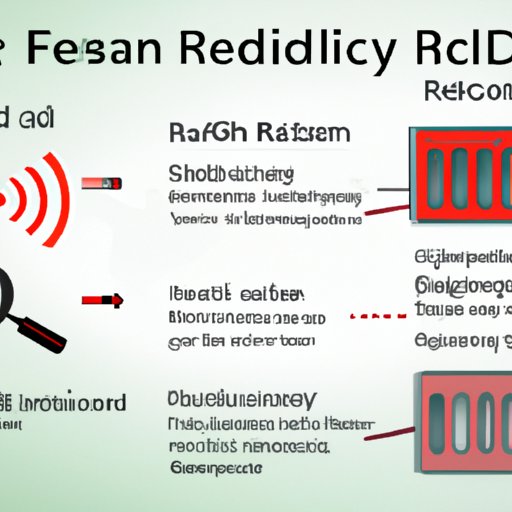Introduction
RFID stands for radio frequency identification and is a form of wireless communication that uses electromagnetic fields to identify and track objects. This technology is used in many industries, including manufacturing, logistics, retail, healthcare and government. RFID technology consists of three components: an antenna or tag, a reader and a computer system. The antenna or tag is attached to the object that needs to be identified or tracked, while the reader communicates with the antenna or tag and sends information to the computer system.

Exploring the Basics of RFID Technology
In order to understand how RFID technology works, it is important to first understand the basics of radio waves. Radio waves are a type of electromagnetic radiation that can be used to transmit data over long distances. They are created by a transmitter and received by a receiver. The transmitter creates an electromagnetic field which is then picked up by the receiver. In the case of RFID technology, the antenna or tag acts as the receiver and the reader acts as the transmitter.
There are two main types of RFID technologies: active and passive. Active RFID systems use powered tags which are powered by an internal battery. These tags can communicate with readers from much further distances than passive tags. Passive RFID tags do not require a power source and rely on the energy emitted by the reader to activate them. This type of RFID is typically used for short-range communication.

The Benefits and Challenges of Using RFID Technology
One of the major advantages of using RFID technology is that it can improve efficiency and accuracy in operations. For example, in the supply chain, RFID tags can be used to quickly and accurately track shipments, reducing the amount of time and money spent on manual labor. Additionally, RFID technology can reduce human error in operations, since it eliminates the need for manual data entry.
On the other hand, there are some challenges associated with using RFID technology. One of the major drawbacks is the cost of implementing and maintaining such systems. Additionally, there are privacy concerns associated with using RFID technology, as the data collected can be used to track individuals without their knowledge. Finally, RFID systems can be vulnerable to interference from other radio signals, which can disrupt the communication between the tags and the reader.
Applications of RFID Technology
RFID technology has numerous applications in various industries, including inventory management, access control, healthcare and retail. In the case of inventory management, RFID tags can be used to quickly and accurately track products throughout the supply chain. Additionally, RFID tags can be used for access control, allowing businesses to better manage who has access to certain areas of the facility. In the healthcare industry, RFID tags can be used to track medical equipment and patient records. Finally, in the retail industry, RFID tags can be used to quickly and accurately track products and inventory levels.
The Future of RFID Technology in the 21st Century
As technology continues to evolve, RFID technology is likely to become even more ubiquitous in the 21st century. According to a study conducted by Grand View Research, the global RFID market is expected to reach $41.9 billion by 2025. This growth is largely attributed to increasing demand for automated processes and improved security measures. Additionally, technological advances such as Near Field Communication (NFC) and Bluetooth Low Energy (BLE) are expected to open up new possibilities for RFID technology in the near future. Potential uses include asset tracking, contactless payments, secure authentication and smart home automation.
Conclusion
RFID technology is becoming increasingly popular in various industries due to its ability to improve efficiency and accuracy in operations. Although there are some challenges associated with using this technology, such as cost and privacy concerns, its advantages far outweigh the disadvantages. Additionally, technological advances are expected to open up new possibilities for RFID technology in the near future. From inventory management to healthcare and retail, RFID technology is set to revolutionize the way we do business in the 21st century.
(Note: Is this article not meeting your expectations? Do you have knowledge or insights to share? Unlock new opportunities and expand your reach by joining our authors team. Click Registration to join us and share your expertise with our readers.)
